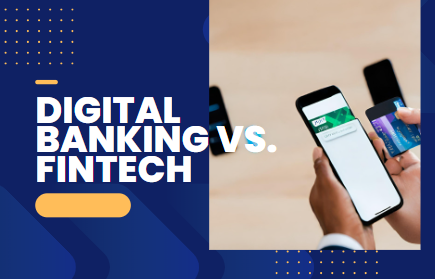Digital Banking vs. Fintech

Okay, this one is a controversial topic that has been making waves in the world of finance. Who’s in? Let’s settle this once and for all.
Do you think Digital banking and Fintech are the same, or do you believe they are totally different? or maybe you’re like my sister, who feels indifferent about this topic.
Well, whichever school of thought you are in, read on as I spill the tea on this controversial topic. I’d talk about the key differences between digital banking and fintech, exploring their respective strengths and the ways they are shaping the future of finance.
Leggo!
The Future of Finance
While these two significant players in the field of finance are closely related and often used interchangeably, they however represent distinct approaches to modernizing and enhancing the financial industry.
At the moment, traditional banks are facing fierce competition (and i mean FIERCE) from innovative fintech companies, leading to a shift in the dynamics of the financial sector. Fintech companies are now partnering with or even obtaining banking licenses to provide a wider array of services.
Right now, the future of finance is likely to be a hybrid model that combines the strengths of both digital banking and fintech. This combination will allow consumers to enjoy the convenience and security of digital banking while benefiting from the innovative solutions and competitive pricing offered by fintech startups. Do you get the gist?
For a better understanding, let’s talk about these two banking services individually.
Can Sparkle Bank Function in Nigeria Without a BVN?
Digital Banking
Digital banking is essentially the digitalization of traditional banking services. It is the extension of traditional banking services into the digital realm. Established financial institutions like banks and credit unions have adopted digital technologies to provide their customers with convenient online and mobile banking services.
With digital banking, you can check your account balance, transfer funds, pay bills, and even apply for loans from the comfort of your home. It’s a convenient way to manage your finances without visiting a physical branch.
So, what then is Fintech?
Fintech
Fintech, short for financial technology, is a broader term that encompasses a wide range of financial services and technologies provided by startups and tech companies.
These companies leverage technology to create innovative financial products and services that challenge traditional banking methods. How so? Fintech startups have introduced new ways of lending, investing, payments, and even insurance, challenging the status quo of traditional banking.
What sets fintech apart is its agility and ability to quickly respond to consumer needs, which I find very intriguing.
These companies are driven by a desire to simplify financial processes and make them more accessible to a broader audience. They thrive on creativity, aiming to eliminate the inefficiencies associated with traditional banking.
Knowing what these banks stand for, let’s talk about their similarities and why most people think they are the same.
Similarities of Digital Banking and Fintech
Digital banking and fintech share common ground in their reliance on technology, focus on customer convenience and security, and their impact on reshaping the financial industry. The ongoing convergence of these two approaches is likely to shape the future of finance, offering consumers a diverse range of options to meet their financial needs.
- Technology Integration
Both digital banking and fintech heavily rely on technology to deliver their services. They utilize online platforms, mobile apps, and digital interfaces to interact with customers and manage financial transactions.
- Customer Convenience
Both aim to provide customers with convenient ways to manage their finances. Whether it’s digital banking’s online account access or fintech’s mobile payment apps, the goal is to simplify financial tasks for users.
- Security Focus
Both digital banking and fintech prioritize security. They employ encryption, authentication protocols, and other security measures to protect customer data and financial transactions.
- Customer-Centric Approach
Both strive to offer a customer-centric approach. User experience and customer satisfaction are essential aspects of their services.
- Competition and Collaboration
While they compete in some areas, digital banking and fintech also collaborate. Many traditional banks partner with fintech firms to enhance their offerings, and some fintech companies seek banking licenses to offer more comprehensive services.
Moving on, let’s talk about their differences
Differences Between Digital Banking and Fintech
Below are some differences between digital banking and fintech
Services Offered
Digital banks typically offer a range of traditional banking services, such as checking and savings accounts, loans, mortgages, and investment products.
These services are often similar to what one would find in a brick-and-mortar bank. WHILE Fintech companies offer a diverse set of financial services and products that go beyond traditional banking. This includes peer-to-peer lending, robo-advisors for investments, mobile payment solutions, cryptocurrency trading platforms, and more.
Customer Base
Digital banking primarily targets existing bank customers who prefer the convenience of online and mobile banking while maintaining a connection to a trusted banking institution.
WHILE Fintech appeals to a broader range of customers, including those who may not have had traditional banking relationships or who are looking for more specialized and tech-driven financial solutions.
Accessibility to Physical Services
While digital banks primarily offer online services, they may still provide access to physical services through partner ATM networks or, in some cases, limited physical branches.
However, these physical services are usually minimal. WHILE Fintech companies typically do not provide any physical services or locations. Their services are entirely digital, and customers interact with them through apps or websites.
Regulation and Compliance
Digital banks are subject to the same banking regulations and compliance standards as traditional banks, ensuring a high level of oversight and consumer protection. WHILE Fintech firms, while subject to regulations, often operate in a less regulated environment, allowing for more flexibility in developing and launching financial products.
Market Entry and Innovation
Digital banks often enter the market as extensions of established banks, leveraging their existing customer base. They may innovate more slowly due to the influence of traditional banking practices.
WHILE Fintech companies enter the market as disruptors, driven by innovation and the desire to challenge traditional banking norms. They introduce new financial solutions and approaches rapidly.
Accessibility to Physical Services
While digital banks primarily offer online services, they may still provide access to physical services through partner ATM networks or, in some cases, limited physical branches. However, these physical services are usually minimal.
Fintech companies, on the other hand, typically do not provide any physical services or locations. Their services are entirely digital, and customers interact with them through apps or websites.
Customer Service Approach
Digital banks often provide customer support through a combination of digital channels (chat, email, and phone). They may also offer limited in-person support at physical branches, if available, WHILE Fintech companies prioritize digital customer service, offering responsive support through online chat, email, and help centers. Some may not provide phone support at all, relying solely on digital communication.
Conclusion
Digital banking and fintech represent two distinct approaches to modernizing the financial services industry. While digital banking extends traditional banking services into the digital realm. Fintech leverages technology to innovate and create new financial solutions.
The convergence of these two approaches holds great promise for the future of finance, offering consumers a diverse range of options to meet their financial needs.
So now, do you still think they are the same?



